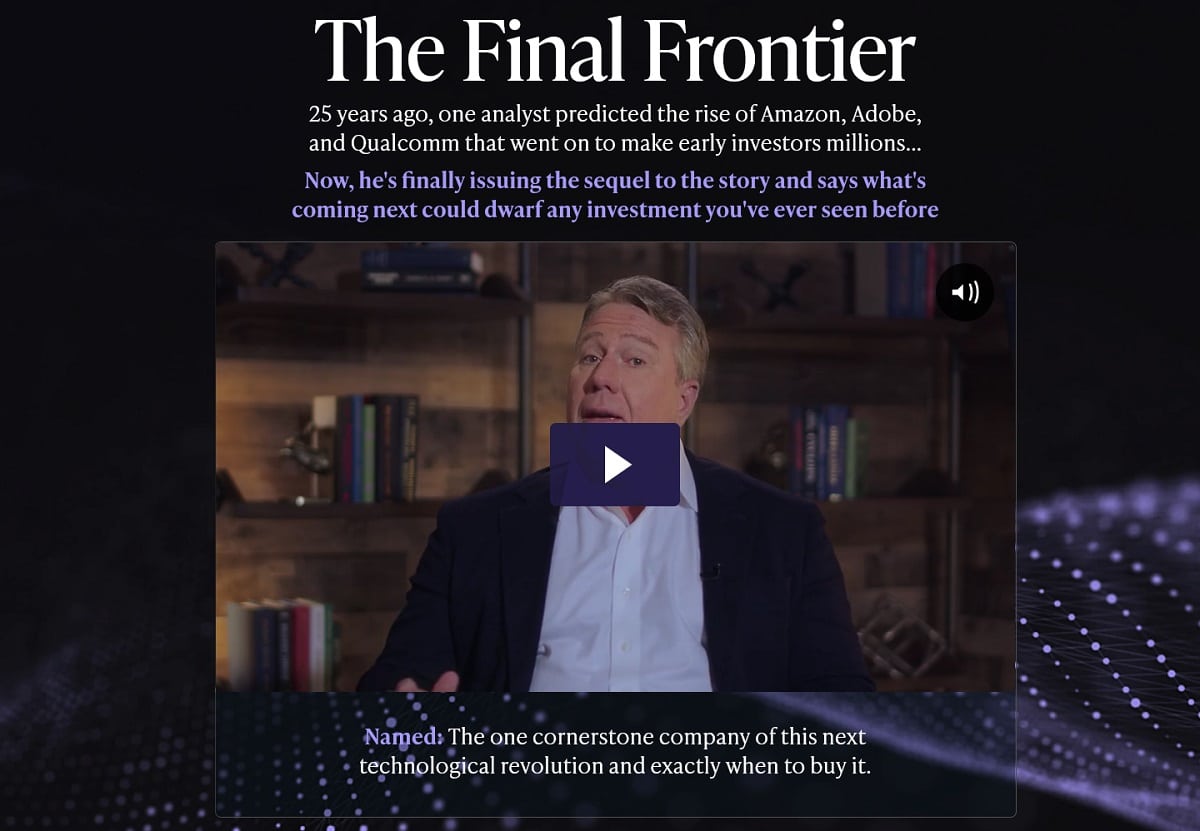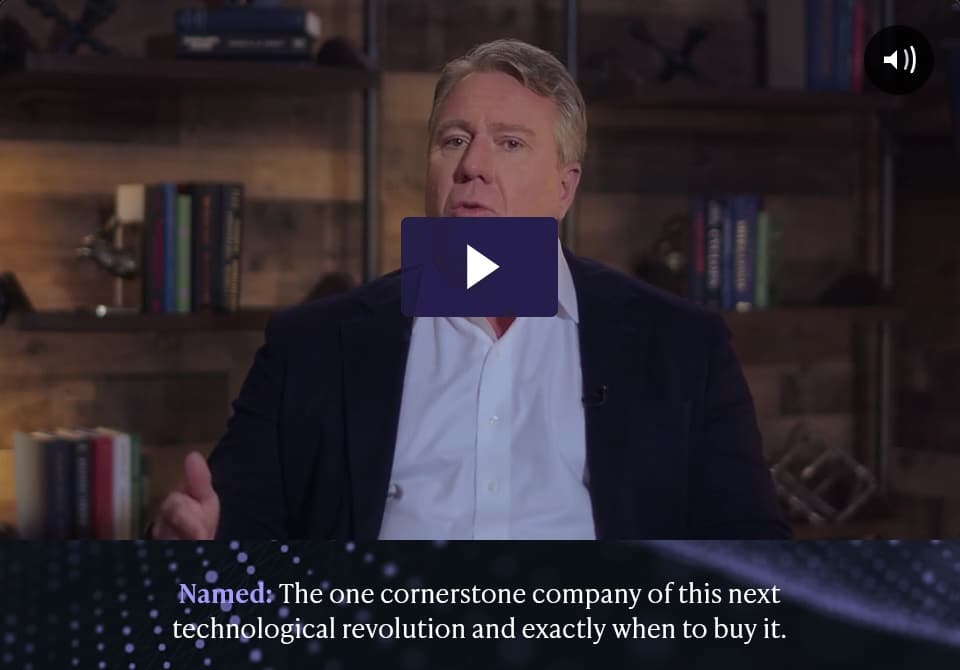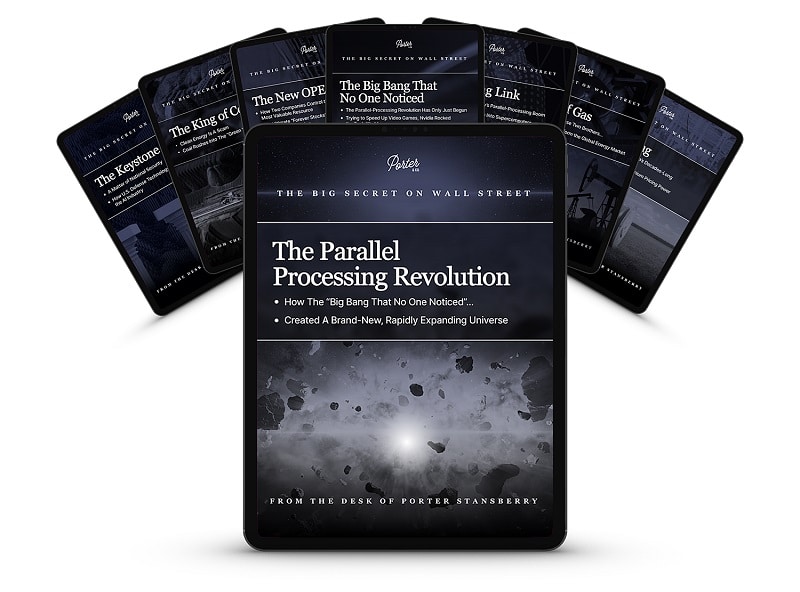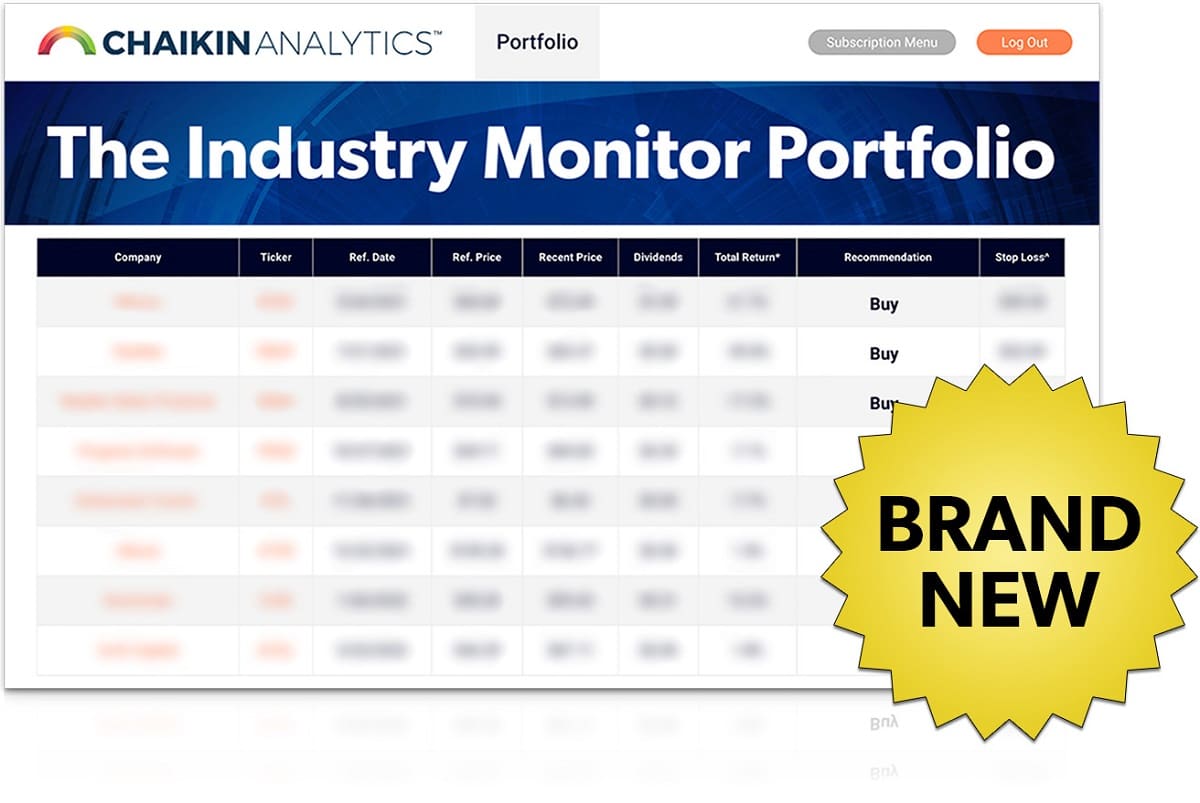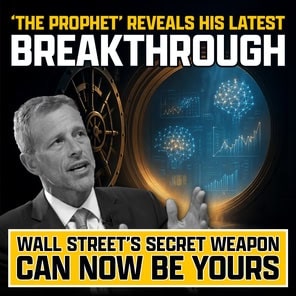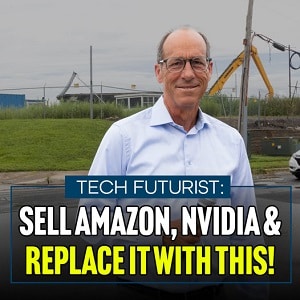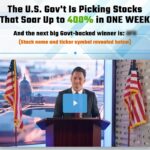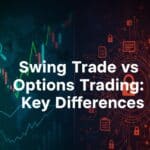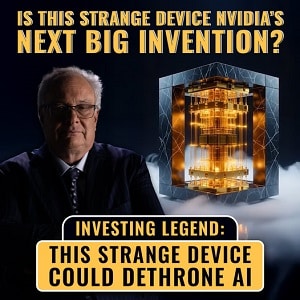Porter Stansberry has launched an intriguing new presentation titled “Parallel Processing Revolution Stocks: The Final Frontier.” In it, he aims to uncover the next big opportunities in the realm of artificial intelligence, accompanied by a selection of exclusive reports on closely related subjects.
These special reports are as follow: “NVIDIA’s Secret Partners,” “The King of Coal,” “The Gods of Gas,” “The Keystone,” “The Big Long” and “The Cool Kid on the Block.”
He’s adopting a well-trodden approach that Porter & Co. has utilized in the past, offering a collection of specialized reports for a set price (this “Parallel Processing Revolution” bundle is priced at $199), as opposed to providing a subscription to his The Big Secret on Wall Street newsletter (which encompasses all these reports and ongoing insights, carrying a price of $1,000 per year).
You can watch full Porter Stansberry “The Final Frontier” presentation here or go straight to the order page and get this “Parallel Processing Revolution” bundle here.
Below is the full transcript of the “Parallel Processing Revolution Stocks: The Final Frontier.” presentation.
Porter Stansberry’s AI’s Final Frontier
I never thought I would see this again. I thought that what happened 25 years ago was a once in a lifetime event. But how wrong I was.
A quarter of a century later, almost to the exact day, it’s all happening again. And it’s about to append everything. For those who understand what’s unfolding, this could be one of the greatest wealth building opportunities of their lives.
But for those who bury their heads in the sand, this threatens to wipe out years of investment returns and could even destroy your financial future.
Here’s the story.
25 years ago, I started telling my family, my friends, and anyone else who would listen about an unprecedented societal shift that was barreling down on all of us.
I discovered a new technology was about to unleash massive, almost unimaginable changes in America. I likened the impact of these new technologies to the railroad boom of the 1800s, to the Industrial Revolution, and to the rise of personal computing.
At the time, I was working as an investment analyst for an elite research group. But my colleagues and my bosses didn’t believe me. No matter what I said, they simply would not acknowledge that the sand was shifting beneath all of our feet.
The legendary Dr. Kurt Richebacher, who was one of the world’s leading Austrian economists, even called me and my ideas radical. But I was certain this new technology was going to trigger a transformation that was unfathomable to most people. And I knew that those on the frontier could reap financial returns unlike anything the world had ever seen before.
So I put my entire career, not to mention every cent I had on the line to spread the story myself. I left my job as a research analyst. I went home to my third floor apartment in one of Baltimore’s worst neighborhoods.
And with a borrowed laptop computer, I wrote my first financial prophecy. And in an investment paper that’s now been read by more than 100,000 people, I explain how endless miles of new fiber optic cables being laid all across the country were creating a new kind of railroad across America, and that this new railroad was going to completely append the telecommunications industry and create an entirely new internet economy.
I also warned that this new railroad would decimate some of America’s most dominant companies, like the long distance provider AT&T. At the time, this was outlandish. With analysts calling AT&T dominant, unstoppable and the giant that no other company can topple. But those who are willing to open their minds to my called radical ideas were not only able to style these companies before they collapsed, they had the chance to get in early on the companies that would go on to build an entirely new internet economy.
I recommended Amazon, Adobe, Qualcomm, Uniphase, Texas Instruments. Those firms are household names now. But when I first recommended them in the late 1990s, they were virtually unknown by most investors. Since then, I’ve issued a number of other financial prophecies, almost all of which have come to pass precisely as I predicted.
But today, I’m stepping forward with something new. It’s a new prophecy.
And I believe it will surpass anything I’ve ever done before. I’m calling it my final prophecy because I don’t think we will ever see another story that rivals the magnitude of this during my lifetime.
And I’m not talking about AI or quantum computing, augmented reality, the blockchain, or anything else that you’re probably thinking about. No, this is something far bigger than all of those things. In fact, this is the cornerstone that all of our recent technological innovations have been built upon, and the future will be built upon too.
Yet, you’ve likely never heard of it before. Outside of some labs in the world’s most prestigious universities and tech companies, almost no one has heard of this. But those who have, those who can see the writing on the wall, they’re actually investing billions of dollars right now as they know that this will transform everything.
Big investors like Marc Andreessen, Ben Horowitz, Elon Musk, Jeff Bezos, Mark Zuckerberg, Jensen Huang, Bill Gates, the list of major investors involved in this new idea goes on and on. They as I do that in a few years from now, we will not recognize the world that we live in today.
Everything is about to change, how we work, how we live, how we communicate, how we transact.
It will all be completely upended by what’s happening next. So today, for the first time, I’m going to share it all with you. And I promise, you’ve never heard anything like this before.
You see, despite the enormous magnitude of this story, no one is yet openly and freely talking about this enormous technological turning point. And that deeply concerns me. Because I believe the emergence of this new technology will draw an incredible demarcation across our higher society.
And on one side, you’re going to have the people who understand this, who invest in it, and who become enormously enriched by it. But on the other side, you’ll have those who turn a blind eye and are impoverished by the sweeping changes that are about to occur. I know what side I want to be on, and I know what side I’m trying to make sure you can be on.
So while our research is typically reserved for the paying customers of my boutique financial advisory, due to the all encompassing importance of this, I’m pulling back the curtain to make sure that you are not left behind. So over the next couple of minutes, I’m going to show you exactly what this new innovation is.
Porter Stansberry’s Prediction
I’ll show you how it’s ushering in a new technological era that’s bigger than AI, bigger than robotics, bigger than the Metaverse. It’s bigger than anything else you’ve ever seen before. And I’ll show you where it’s taking us next. And most importantly, I’m going to tell you what this all means for you and your money, and why this could trigger the next great transfer of wealth in our country.
And there’s more. But be warned, there is a dark side to this story. You see, while the future of this new technology is certain, it’s written in stone. The road ahead is going to be bumpy and is paved with big hazards. And in a mirror of every big tech revolution, whether it was the railroads in the 1800s or the dotcom boom in the late 1990s, investing in the underlying trend was always the right thing to do.
But if you own the wrong companies or even if you bought the right companies but at the wrong time, you could get wiped out. But don’t worry, I’ll name the companies that you need to know about, both the ones to own and the ones to avoid. And no, you won’t have to become a paying subscriber to take advantage of any of this.
I’m going to lay everything out for you right here in this video. So whether you are enriched or impoverished during this new era, it all comes down to what you do right now. Let’s get started.
For those of you who don’t know me, my name is Porter Stansberry. I’m the founder of one of the largest financial research firms in the world. More than 16 million people from 100 countries all around the world read my work.
And over the last 25 years, I’ve helped investors navigate almost every major economic cycle. We’ve also been on the forefront of every big tech story, from the rise of Bitcoin, and mRNA vaccines, to robotics, AI, and more.
However, I didn’t think I’d ever see another transformation of this kind of scale in my lifetime. You see, while there have been thousands of new inventions and innovations in almost every field over the last few decades, these are typically incremental improvements, and they move in a linear fashion.
You can see the technology advance from A, to B, to C.
But this isn’t like that. This is a bona fide paradigm shift that will change everything. These kinds of changes only come along once in every, I don’t know, generation, 30 years, 50 years.
I’m talking about a technology with an impact the printing press, the steam engine, or personal computers. Well, I’m well aware of how hyperbolic that sounds, I’m willing to stake my reputation and my career on this prediction. And once again, I’m willing to bet that those who are on the frontier with me are going to make millions over the long run.
In fact, it’s already all happening. Goldman says more than 1,600 new millionaires are being created every day as a result of this new technology.
And as you’ll see, that’s only the beginning. The wealth, the prosperity, the innovations that will be fueled by this revolution are going to be greater, bigger than anything we have ever seen before.
I don’t expect you to take my word for it, though. So all I ask is stick with me for the next few minutes, and then you can decide if I’m crazy or not. Just remember, people thought I was crazy in 2007 when I predicted the collapse of Fannie Mae, Freddie Mach, the entire mortgage business.
I also predicted the bankruptcy of General Motors. And people thought I was crazy. In 2008 when I said that the biggest mall owner in America and one of the biggest newspapers in the country would go bust. But then they did.
People thought I was crazy when I warned that we would see riots in the streets after the financial crisis. But then the Occupy Wall Street movement erupted. People thought I was crazy in 2012 when I said that oil prices would go from over $100 to less than $40 a barrel. But then it happened.
And people thought I was crazy last year when I said that Boeing was on the road to ruin, and then their plane started to fall apart mid-flight. I’m telling you right now, most people are going to say that this is crazy too. But that’s exactly what makes this story The Biggest Secret on Wall Street today, the type of under the radar idea that my partners and I have spent the last 25 years uncovering for our readers. And we have proven that we have the potential to deliver asymmetric returns to those who get in at the right time.
America’s Final Frontier – What Is All About?
So this story starts when three academics from the University of Toronto entered a computer science competition. Just a game. While you’ve likely never heard of the ImageNet large scale visual recognition challenge, it’s the Super Bowl of the computer science world.
Every year, the best of the best computer scientists come together to pit their deep learning algorithms against one another. But up until this point in history, the progression of these algorithms had been very slow and steady.
Each year, they would get a little smarter. But winning was a game of inches until our three Canadians showed up. Their new algorithm didn’t just win this competition, it beat everybody else by a previously unimaginable margin.
In fact, their AlexNet algorithm was so dominant that the computer science world was thrown completely upside down. As Andrew Ing, who’s the co-founder and head of Google Brain, says, the results were a quantum leap. Ian Goodfellow, who’s the director of deep learning at Apple computer, said, this moment catalyzed widespread adoption and research in the field.
It was such a defining moment that insiders still call it the Big Bang for machine learning and artificial intelligence. But what almost everyone misunderstands is this algorithmic advancement wasn’t the real breakthrough, not at all. What matters is how the AlexNet team did it.
You see, at that moment, they irrevocably transformed the entire world by using a new type of processor, a new type of computer to train their algorithm. And it was that decision to use a new processor that has laid the foundations of an entirely new era of technology and computing.
This is an era that has given birth to everything from AI, to cryptocurrencies, to new vaccines, to augmented reality. This kind of computing promises to generate trillions of dollars in profits in the years ahead.
Before AlexNet, before the Big Bang, computer processing was done using a process called serial computing.
Tasks are executed one at a time, one after the other in a serial process. You can think about it like dominoes. Dominoes are a serial process. First domino falls, then the second, and so on. With each domino being reliant on the preceding one for the process to continue.
This is how computers have operated for the last 70 years, ever since Remington Rand Corporation built the very first CPU. These CPUs, Central Processing Units, are the brains of a computer. And since their invention, they have improved by about 50% a year the famous Moore’s Law.
However, despite CPUs phenomenal processing power, they are constrained by the fact that they can only process one task at a time. And after a half a century of growth, computing power was beginning to stagnate. This was especially clear in the fields of deep and machine learning. Even the most advanced supercomputers packed with thousands of CPUs couldn’t provide the computing power required.
That’s because the number of operations needed for just one of these algorithms can rival the total number of grains of sand on Earth. Huge amounts of computing power was needed. And the breakthrough of the AlexNet team was that they built their algorithms to work with a new type of computer chip, a graphical processing unit.
These GPUs, which were originally built to render computer game graphics, have a unique ability. They can process millions of operations at the same time. Going back to our domino analogy, instead of each one being knocked over in a series, imagine thousands of lines of dominoes, all falling simultaneously.
That creates an entirely new kind of computing capacity. And it’s exponentially greater, not linearly greater than anything that serial processing CPUs could have ever done. And it was this breakthrough of writing their algorithm on GPUs instead of CPUs that’s unlocked a whole new era of computing.
It’s what I call the parallel processing revolution. And in the same way, serial processing gave us personal computers, the internet, smartphones, and countless other innovations. Parallel computing will usher in a new technological era that creates vast, vast amounts of wealth for those who understand the changes that are coming.
By the way, that’s not a prediction. This is already happening right now today. Almost every technological advancement that we have seen over the last several years was built with parallel processing, talking about OpenAI’s ChatGPT, that’s powered by parallel processing.
If you look at how Tesla is designing their self-driving cars, again, parallel processing. Boston Dynamics, the company that makes the dancing robots, that’s all because of parallel processing. Even Mark Zuckerberg’s Metaverse, which was a flop, the technology behind it was parallel processing.
And if you look at the leaders in accelerated drug discovery, like AstraZeneca, they’re all doing it with parallel processing. Without the processing power of these GPUs, none of these technologies would be possible. And that is just a taste of what’s to come. That’s just the first things we’ve seen.
Healthcare, biotech, automotive, AI, manufacturing, cybersecurity, banking, construction, finance. Every sector of our economy is adopting parallel processing in some form, with one estimate putting the market today at a staggering $100 trillion. And there is one company that has a monopoly on all of it.
The first computing revolution, the era of serial processing, was dominated by three companies. You probably know these businesses well. Intel engineered the CPUs, Cisco built the communication networks, and Microsoft created the operating systems. Together, these three companies, more than any others, shaped the first era of computing.
That’s happened over about the last 40 years. With the combination of their software and hardware, allowing these companies to form an oligopoly that controlled the entire sector. Anyone who wanted to leverage the power of computing or the internet, whether it was a corporation, an individual, or even our governments, they had to pay to play in those company’s sandbox.
And as this computing market grew by billions and billions every year, those three firms reaped the lion’s share of the resulting wealth. Case in point, if you had bought each of those three companies at their IPO, you could have turned a $10,000 investment into each of those businesses into almost $45 million today.
That one investment alone was all you needed to do over the last 30 years to outperform virtually everything else in the financial markets. In other words, knowing which firms would control the keys to serial computing could have beaten almost every other hedge fund and professional investor in the world. Today, exact same thing is happening.
Parallel Computing
A very, very similar setup is emerging in parallel computing. And this investment setup is going to give you an incredible second chance at making those kind of life changing returns. Obviously, past performance is never an indication of the future.
There’s no guarantee that this second computing era will be as transformational. In fact, I believe it’s going to be way bigger. The emergence of GPU processing is going to usher in a technological age that you cannot imagine, and trillions of dollars in wealth will be created.
What’s most exciting is that we don’t have to guess about who is going to end up controlling the keys to the parallel processing kingdom. Because there is one company that has already established control over the entire ecosystem. They design the GPU chips, they own the programming platform, they own the communication lines.
And I’m talking, of course, about NVIDIA, the center and the master of the parallel processing universe. Not only does NVIDIA design, by far, the best in class parallel processing GPUs, they control 80% of the market. Not only do they own the programming platform for writing GPU based programs, but they’ve already established that software.
It’s called Cuda as the industry standard. But in what has been described as one of the best acquisitions of all time. NVIDIA bought an obscure company called Mellanox.
You’ve never heard of Mellanox. But they are like the Cisco of the parallel processing world.
You see, in order to harness the full potential of parallel processing, thousands of NVIDIA’s GPUs are stacked together in gigantic racks like these. The GPUs then work in tandem to produce compute power that is so far greater than the output of any single GPU, it’s simply hard to imagine.
But to achieve this incredible computing power, the GPUs have to be able to talk to each other almost instantly. Mellanox makes the high speed wires and connections that allow all these GPUs to work together simultaneously, thus unlocking unparalleled computing power.
NVIDIA’s dominance in these three areas gives them a near total monopoly over the entire parallel processing ecosystem. Anyone who wants to harness the power of GPUs and parallel processing, anyone who wants to leverage machine learning, anyone who wants to operate in this new computing era, they need NVIDIA. There is no other viable choice today.
As Forbes puts it, they own the keys to the parallel processing kingdom. It’s why Amazon, Alphabet, Meta, Microsoft, Tesla, Dell, and practically every other big tech company are all NVIDIA customers. It’s why they can charge far more for their GPUs than any competitor with their latest Blackwell model costing up to $40,000 per chip. It’s why they have unheard of 55% profit margins, a feat only a small handful of technological companies could ever rival.
And while there are competitors that are trying to challenge NVIDIA’s monopoly, as one venture capitalist puts it
“The bottom line here is it’s nearly impossible to compete with them head on. And if anybody’s going to unseat NVIDIA, it’s either going to be from some unknown flank attack that they don’t see or the future will turn out to just not be parallel computing, which seems very unlikely.”
Yet, I’m not suggesting that you buy NVIDIA today. You see, despite all of these things, buying NVIDIA at today’s prices could lead to losses of 50% or more.
While that may seem crazy right now, just remember, it’s happened three times before.
The first was in the early 2000 when the dotcom bubble busted. It sent NVIDIA crashing by almost 90%.
The second big NVIDIA crash was during the financial crisis. The stock plunged from a split adjusted $1 per share to less than $0.25.
And the third time was when the crypto mania peaked in late 2021. NVIDIA shares collapsed by 65%.
I think the fourth big NVIDIA crash is coming. And when it arrives, it could drag the entire tech sector down with it, destroying trillions in wealth practically overnight.
We’re in the midst of the greatest financial bubble of all time right now. Like all bubbles, it was created by vast amounts of newly created credit. This time, through the 2023 bailout, the hidden bailout of our banking system. While the financial system was already running red hot from trillions in COVID spending and Biden’s infrastructure boondoggle, the Fed then created something called the bank term funding program.
And this was designed to paper over the banking systems, $500 billion in losses on their government bonds. So instead of seeing a reduction in credit while interest rates were rising, the Fed issued more than $164 billion in new credit. This coincided with the mania around AI.
And the result, a huge financial boom that is equal to the irrational exuberance of the early 2000s. Of course, most analysts have managed to delude themselves into believing that this time is different. They claim the valuations of mega-cap tech stocks aren’t extreme as they were in the dotcom bubble. But the reality is, it’s actually worse.
Analysis from Apollo Capital Management shows the valuations of the top 10 companies are greater than those of the 2000s. And I don’t need to tell you, but these nosebleed numbers are simply not sustainable. Take NVIDIA for example.
It is traded as high as 45 times revenues and 218 times earnings. To put this into perspective, listen to the CEO of Sun Microsystems, the one-time dotcom darling, as he explained why that’s not sustainable.
SCOTT MCNEALY: “At a valuation of 10 times revenues to give you a 10-year payback, I have to pay you 100% of revenues for 10 straight years in dividends. That assumes I can get that by my shareholders. That assumes zero cost of goods sold, which is very hard for a computer company.
That assumes zero expenses, which is really hard with 39,000 employees. That assumes I pay no taxes, which is very hard. And that assumes you pay no taxes on your dividends, which is kind of illegal. And that assumes with zero R&D for the next 10 years, I can maintain the current revenue run rate. Do you realize how ridiculous those basic assumptions are? What were you thinking?”
PORTER STANSBERRY: NVIDIA isn’t trading at 10 times revenues, though, like Sun Microsystems was. It’s trading far, far higher. Even for world class firms, we know where bubbles like this end. Consider Cisco in the late 1990s.
No one came close to Cisco’s dominance. Cisco had roughly 75% of all the internet traffic going through their routers and infrastructure. From its February 1990 IPO through the year 2000, Cisco shares compounded at an unbelievable 102% per year. At its peak, Cisco was the largest company in the world, valued at more than $500 billion, or roughly 60 times sales.
Even after the internet bubble burst, Cisco continued to grow, with revenues increasing at around 10% per year. There was only one problem. This was a significant deceleration from the 40% annual growth they experienced between ’95 and 2000.
And when you’re valued at 60 times sales, you can’t afford even a modest slowdown in growth or else your stock is going to crash. So despite revenues growing four-fold since 2000, early investors in Cisco have suffered two decades of negative returns. And just like Cisco in the dotcom era, NVIDIA is now priced for an impossible perfection.
As one analyst details.
PIETER SLEGERS: “NVIDIA needs to generate $354 billion in free cash flow 10 years from now to justify the current stock price. That’s as much free cash flow as what Apple, Alphabet, Amazon, Microsoft, Tesla, Netflix, Meta Platforms, MasterCard, and Visa are generating combined today. And that’s to generate just 10% per year to shareholders.”
In other words, NVIDIA has to execute absolutely flawlessly for the next decade at least. And anything less than absolute perfection, any loss of market share, any deceleration in sales will lead to a massive loss. Betting on perfection is a fool’s errand in any environment, but it’s especially foolish at the peak of a colossal financial bubble, a bubble that’s hovering inches above several sharp pens.
What’s the exact pin that will pop the bubble?
There’s no way of knowing. But I’m certain it’s coming. And I believe it’s going to happen soon.
It could be the slowing economy. It might be fallout from a contested 2024 election. It could be the ticking time bomb of unrealized losses in the banking sector. It might be the collapse of a big private equity firm because of losses in commercial real estate.
It could be an invasion of Taiwan. It could be a war between Iran and Israel. There are an unlimited number of black swans that we can’t see. But really, it doesn’t actually matter because the end result is going to be the same.
When this bubble pops, there will be cataclysmic losses for those investors who failed to see the writing that is clearly on the wall. And that’s terrible news. But the good news is, in the aftermath of that collapse, you’ll be able to buy NVIDIA for as low as 15 or 20 times earnings.
It’s buying the world’s best companies like forever stocks with indomitable monopolies. At these times, that will make you a very successful investor.
Consider Berkshire’s purchase of Apple computer. For years, Berkshire ignored technology stocks.
And of course, they were criticized roundly for it. The popular narrative, which was subtly encouraged by both Buffett and Munger, was that they didn’t understand tech companies. Of course, the idea that two of the world’s greatest investors couldn’t wrap their heads around a tech company is ludicrous.
They were simply biding their time. They ignored the hype. They ignored the fear of missing out. And they waited until Apple was trading at 10 times earnings. Then Berkshire backed up their very big truck.
And while I’m not saying that NVIDIA will deliver returns like this, I am saying that when you buy is as important as what you buy. Now, with a tech crash looming, I’m urging you to resist the fear of missing out. I’m urging you to wait for the right moment to buy.
Because there is no doubt that parallel processing will be among the most transformational technologies of our lifetime, the transformational technology. And there’s no doubt that NVIDIA is the 800 pounds gorilla in this space. But buying at today’s prices involves too much risk, especially when there are far better ways to capitalize on this revolution.
The Parallel Processing Revolution
And that’s why I want to send you a copy of my brand new briefing that covers all of this in far more depth. Inside, you’ll get all of my research into this new era of computing and why it’s so transformative. You’ll also get a full analysis of NVIDIA’s business, why they are the center of the parallel processing universe, and why they cannot be unseated.
Most importantly, you’ll get our analysis into when and what price we would recommend investing in NVIDIA for maximum upside potential. NVIDIA is just for starters, though. Because you’re also going to get the names of what we call NVIDIA’s secret partners. And as you’ll see, without these three other companies, NVIDIA’s business wouldn’t be possible.
That’s because each of them plays an almost impossible to replicate role in the development of NVIDIA’s GPUs and CPUs. Partner number one owns the only machines in the world that are capable of manufacturing the sub 10 nanometer chips inside NVIDIA’s GPUs.
Over the last decade, this company has compounded its revenues at an annual rate of 17%. And with the GPUs accelerating, the trend is going to continue. Secret partner number two is what I call the new OPEC, because this company controls 90% of a critical resource that’s needed for the manufacturing of GPUs.
Like OPEC, their monopoly gives them unbridled pricing power and control over the businesses that require their material. They use this market power to earn 40% net income margins, and they should be able to continue growing these margins for years. This is one of the most profitable, well run businesses in the entire world. And I’m pretty sure you’ve never heard of it.
And then there’s secret partner number three. Unlike NVIDIA’s other partners, this firm operates in the realm of intellectual property and design. Instead of capital intensive manufacturing, they simply design the blueprints for the world’s top performing GPUs and CPUs. And the beauty of their business is that they’re able to create the design once, and then sell it to companies who can use it for years. But they have to pay them each and every time they use it.
That makes this business one of the most capital efficient I have ever seen. Case in point, this company invests less than $100 million a year in CapEx and generates over three billion a year in revenue with roughly $1 billion every year in free cash. And inside my new briefing, “The Parallel Processing Revolution”, you’ll get a full analysis of each of these three companies and why they could be among the greatest compounders of wealth over the next two decades, potentially growing by double digits every year for years to come.
Before I tell you how to get your copy, there’s one more big part of the parallel processing story I haven’t told you about yet. And it’s here that I believe actually you’ll find the greatest investment opportunities.
For the parallel processing revolution to get fully underway, a number of major roadblocks still have to be removed. You see, almost all of America’s systems and infrastructure were built for the demands of serial, not parallel computing.
And in order for us to harness the full economic and financial potential of parallel processing, hundreds of billions still need to be invested in our aging infrastructure. I’m talking about data centers, telecommunications, factories, fiber optic networks, power transmission lines, satellites, manufacturing, transportation. They all need to be overhauled to support this new era of computing.
And of course, the costs for this are going to be absurdly high. However, it is essential if America wants to maintain its technological and economic lead in this new computing age. And as a result, hundreds of billions of dollars from the public and the private sector are now being poured into this new infrastructure build out.
Blackstone, BlackRock, JP Morgan, Sequoia Capital, and dozens of other Wall Street firms are investing billions in this new infrastructure. The federal government has launched federal grants and incentives to the tune of over $2 trillion. The big tech Giants are all investing tens of millions, if not billions of dollars more into parallel processing infrastructure too.
I could go on. But you only really need to know one thing. We are on the cusp of a multi-year, multi-billion dollar CapEx boom that’s going to act as a groundswell for a number of other sectors in our economy. And if you own the right companies in these sectors, you’re going to be looking at some of the greatest financial returns you’ll ever see.
As you discovered earlier, while the processing power of parallel computing is exponentially greater than the serial processing, so too are the energy demands.
For decades, the power demands followed Moore’s Law. However, right here, when the AlexNet team started using GPUs, Moore’s Law was shattered.
Almost overnight, the power demands for computing went from doubling every 20 months to doubling every six months. And that continues to accelerate.
This is where the first big problem lies. Training, developing and operating these parallel processing programs requires unbelievable energy demands, energy demands that we cannot possibly meet. Case in point.
In serial computing, a typical server rack consumes 100 kilowatt hours of electricity every day. That’s roughly three times the power that’s used in a family home.
But a GPU server rack for parallel processing, that uses 10 times more energy per rack.
That means on average, every GPUs based data center, it’s consuming enough electricity to power 50,000 homes. And with the big tech firms in an arms race to convert over 600 data centers from serial CPUs to parallel processing GPUs, the combined energy consumption of all of these facilities will be the equivalent of 30 million homes.
That’s about 25% of all of the US households. And that’s from their existing data centers that are being converted. There are, of course, construction plans and permits for almost 400 new data centers across America right now today.
In total, it’s estimated that more than $1 trillion will be spent on data centers in just the next 5 years, and that those data centers are going to end up consuming almost 10% of all the electricity that’s produced in the United States. Our political leaders and their infinite wisdom tell us this is no problem.
We’ll simply meet the exponential energy demands with renewables. But the reality is, no matter how loudly these morons insist that rainbows and butterflies can feed America’s insatiable energy appetite, the physics don’t lie. Consider this. In order to meet the government’s goal of the grid being 80% powered by renewable energy, it would require solar and wind power to reach a combined output of 6.8 trillion kilowatts per hour of annual generation capacity.
Putting aside the fact that we can’t mine enough copper, lithium, cobalt, or nickel to make this happen, it would also cost several trillion dollars. And while people like me have long warned of this looming energy crunch, it’s only now, after years of delusion, that the environmentalists are waking up.
Take Ernest Moniz or Ernie, as we call him. He was the Secretary of Energy under President Obama. And he has been one of the most zealous disciples of what I call the Church of climate change for decades. But even Ernie can’t deny the reality any longer.
He recently admitted, we’re not going to build gigawatts of new renewables in a few years. He’s right about that. He then went on to commit the ultimate blasphemy by saying, the only way that we can meet our exploding energy demands, get ready for it, is through natural gas and coal.
No kidding. It’s too little too late for Ernie, though. After decades of propaganda preaching the abhorrent evils of hydrocarbons, US utilities have an upgraded power generation capacity for 15 years. This has created an extreme energy crunch that the establishment is desperately trying to reverse.
It’s why the Phanatic push to close coal plants is suddenly slowing, with dozens of coal plants quietly being put back into action. It’s also why Biden and Kamala quietly ramped up oil and gas production despite promising voters that they would end fossil fuels.
But it’s not enough. As the parallel processing revolution gathers steam, soaring energy demands will continue to outpace supply by a mile. And this has created one of the greatest investment setups I’ve ever seen.
In fact, the last time the environment was this perfect for an investment was in the late 1990s. As investors got swept up in the mania of the internet boom, they ignored other old economy sectors like energy. By the peak of the dotcom bubble, the energy sector was historically cheap. The direct inverse of the overvaluation in the tech sector when the dotcom bubble burst, there was a massive reversion to the mean that resulted in energy stocks soaring.
Over the following decade, they not only outperformed tech stocks, but also the broader market. Investors who had been going against the grain and buying energy stocks at their historically low valuations made a killing. And the same exact thing is happening right now today.
Except this time, the returns are going to be even greater. Not only has progress in the sector been suppressed due to years of ridiculous anti-fossil fuel rhetoric, but investment in new facilities, new exploration, new drilling and new infrastructure has massively declined. All at a time, when the world economy needs energy more than ever before.
The King of Coal
And I believe there are two little known companies that are going to be the biggest beneficiaries of all from this incredible supply crunch. The first business is what I call The King of Coal. While owning this company will not endear you to your liberal friends, it could make you so much money that you could just buy some new ones.
You see, while environmental activists have managed to get hundreds of coal plants shut down since 2008, their activism has had a number of unintended consequences that The King of Coal has been able to exploit. For example, after slashing the number of active coal mines by 72%, what do you think happened to prices for coal?
They have been steadily increasing over the past several years. And The King of Coal has capitalized on this, scooping up coal mines for pennies on the dollar and consolidating the market. Now, The King of Coal’s share of the market is up by 50% since 2017.
And last year, this company mined a colossal 26 million tons of coal. The result, over $2.5 billion in revenue, almost $700 million in free cash flow. That’s a 30% free cash flow margin for a mining company. That rivals the world’s best technology giants.
These incredible results are why The King of Coal has delivered returns of, get this, 364% since 2017. That’s an annual compounded return close to 30% That’s roughly double the S&P 500’s return. And this is going to continue.
I believe you’re going to see market crushing returns like this in coal for years to come. Because guess what, Wall Street still won’t touch this stock. The fear of being labeled non-woke keeps hedge funds and pension funds away.
You can still buy this company right now for about 5′ times its free cash flow. That’s super cheap. And as the demand for coal skyrockets in the coming years, both here and abroad, The King of Coal is going to reign supreme.
Inside my investor briefing, you’re going to get the full report that I wrote about this phenomenal coal company, along with an in-depth analysis into why we believe coal will continue to see massive demand both here and abroad. But coal alone, even with as much of it as we have, is not going to be enough to meet the insatiable energy demands of the parallel processing revolution.
That’s why despite years of political pledges to end hydrocarbons, another dirty fuel is seeing an all time high usage. I’m talking about natural gas. Today, more natural gas is being used for power generation than in any other time in our country’s history.
What’s more, as the promises of solar, wind, and other renewables fail to materialize, natural gas is share of power generation is expected to grow by almost 20% according to S&P Global. I believe there is one little known natural gas company that is best positioned to capitalize on the incredible demand for natural gas to make electricity.
And you’ve probably never heard of this company. I call the people who run this business the gods of gas. And I believe they’re going to soon be one of the most valuable companies in the entire world. The business is led by two genius brothers who operate an independent oil and gas firm, and they made the best energy deal I have ever seen.
Back in 2020, when the pandemic sent oil and gas prices all the way down to decade lows, there was one major oil company that simply decided it wanted to get out of gas. And so it wrote off its entire investment in the enormous Marcellus Shale. The gods of gas swept in.
And for just $735 million, $735 million, they purchased this entire Marcellus acreage, which was an $8 billion write down for the major oil company. That deal gave them 800,000 acres and the world’s most valuable oil and gas fields.
And that deal cemented their position as the dominant provider of Marcellus Natural Gas., and they’re going to be the dominant provider for our country for decades. There is no question. No company will produce more natural gas from the Marcellus or in America as a whole for the next 30 years, at least.
A company like this that’s producing reliable cash flows of $3 billion a year with a proven growth strategy in the best field in America should be worth at least $100 billion, roughly five times more than the stock’s current price. But even that projection of $100 billion market cap is really conservative.
Because while US natural gas prices have fallen to around $2 an MCF due to the production glut, it won’t take long for prices to rise sharply. The coming gas boom is going to be driven by exploding demand for US natural gas exports.
Since 2016, natural gas exports, which are called LNG, those have exploded from zero to 12 billion, that’s BCF, of production. That’s roughly 12% of all US gas. All that gas is currently being exported from only eight export facilities.
But guess what, there’s another 17 LNG facilities that are expected to come online within the next five years. Thus, it’s projected that international markets are going to end up consuming about 33% of total US gas production. As that happens, you’ll see US prices for natural gas equalized with international prices.
And right now, the overseas market for gas is $10 to $12 per MCF. So gas prices in America are going to go from around $2 an MCF to something around $10 to $12 an MCF. And that is going to be a massive tailwind for this business. The guys that I call the gods of gas.
This setup and this company is as great an investment opportunity as I have ever seen in my 25-year career as a financial analyst. And it’s the one stock that I think everyone in America should have in their portfolio. Inside my briefing, you’ll get all the details on this company and our analysis into why natural gas is going to see a huge boom over the next five years.
The Gods of Gas
The King of Coal and The Gods of Gas. Those are only a stopgap, though. You see, while the ruling class has no choice but to turn back on fossil fuels for the next five to 10 years. They also are desperately searching for an alternative, an alternative energy source that’s clean, that’s cheap, and that’s carbon free.
So what are they going to pick? There’s only one viable candidate. It’s nuclear. This is why many of the world’s best entrepreneurs and investors are pouring millions of dollars today into nuclear startups.
Jeff Bezos has raised $130 billion for his nuclear startup Bill Gates has invested $750 million in his. Peter Thiel, the co-founder of PayPal and Palantir, has pledged $2 billion. Warren Buffett, Reid Hoffman, Ken Griffin, Jim Simons, lots of other billionaires are investing millions of dollars too.
The billionaires know as I do. Nuclear energy is the only way to meet the world’s growing energy demands over the next 50 years. And they know it could become the de facto energy source of the entire technology sector.
If so, it’s going to deliver huge returns for investors. However, they’re not buying uranium mines. And they’re not buying traditional nuclear power companies. No. The tech guys are betting on a whole new kind of nuclear energy.
This is a kind of nuclear energy that can provide practically endless, clean energy all across the country. I’m talking about something called a Small Modular Reactor. An SMR is a nuclear reactor that produces nuclear energy but is much smaller than a typical reactor.
That means it has all the advantages of a nuclear reactor with almost none of the disadvantages. These things can produce electricity with less overheating. They can self regulate. They can be paired with renewable resources.
These things can be built in two years as opposed to 10. They can be deployed on top of shuttered coal plants. And we have about 300 of those old coal plants that aren’t working in America right now. Great opportunity.
And SMRs can produce energy for 10 years straight without being refueled, whereas a typical reactor has to be refueled every 18 to 24 months. That’s why, as our energy needs continue to surge, SMRs are gaining the attention of governments all around the world. They know green energy can’t meet the actual demand.
So hundreds of billions of dollars are being poured into the development of SMRs today. Right now, there are 80 different designs that are being developed in 19 different countries. Three have already begun operating, and others are going to follow.
When they do, the roll will never be the same again. For the first time ever, we are going to be able to provide nuclear energy to anyone, anywhere at any time. And we’ll be able to do it without having to spend billions of dollars on reactors that take decades or more to build.
All of this is why small, modular reactors are critical to the long term future of the parallel processing revolution. It’s the only way we can meet the insatiable energy demand that we face without relying on fossil fuels. Right now, dozens of companies are racing to bring SMR to the market.
The Keystone
But we have found the winner. Inside my briefing, The Keystone, I’ll give you all the details that you need to know about this company. I promise, you have never heard of it. But I’m going to explain exactly how I know for sure it’s going to win the SMR arms race.
You’ll get The Keystone, The King of Coal and The Gods of Gas. All of those companies have the potential to do incredibly well over the next five years.
All of these companies, whether it’s NVIDIA directly, or NVIDIA’s three secret partners, or whether it’s The King of Coal, or whether you want to buy The Gods of Gas, or The Keystone, all of these companies are going to benefit enormously from the parallel processing revolution.
And I believe investors should know about all these companies as they’re going to deliver market beating returns for years to come. And that’s why I’ve combined all of these ideas into a special one of a kind briefing that lays out everything for you. You see, while each of these companies is involved in a different aspect of the parallel processing revolution, they are all deeply interconnected.
And in order to fully understand what’s going on, what it means for the future, and how to capitalize on this new computing era, you need to know how their products and their services all intertwine. This report is by far the most in depth equities analysis that we have ever done at Porter and Company. As Dan Denning, a famous financial analyst whose work is followed by high wealth investors and fund managers in 70 countries, wrote after reading it.
DAN DENNING: Porter, this was incredible. I was blown away. Read it tonight in one sitting, and then sent it off with notes to select family members. Something I never do.
You guys have set an incredibly high bar with that caliber of research. Congrats and compliments to everyone who was involved with it. The report alone would be worth the price of a subscription.
The Big Secret on Wall Street
The subscription he’s talking about, it’s the Porter and Company’s flagship financial advisory – The Big Secret on Wall Street. The annual cost of our membership is $1,425. And as Dan put it, this one briefing alone will be worth the cost of membership.
But given the importance of this story, I’m doing something special that will allow you to get our best work without having to spend $1,400. Why? Because over my 25-year career as a financial analyst, I’ve only ever seen a handful of true, can’t miss moments, moments that, if acted on, have the potential to forever transform your financial future.
Moments with the potential to make up for a lifetime of investing mistakes or missed opportunities. Moments with the potential to deliver a lifetime of financial returns from a single decision or even a single investment. Like when I told my readers, that Fannie Mae and Freddie Mac were going to zero, and I recommended shorting both of those stocks.
Or back in 2007, when Hershey’s, the chocolate business, was trading around $40. And I urge my readers to buy it, calling it my best no-risk opportunity ever. I even went so far as to say, it could easily become the best investment you make in your entire life.
And check the stock. It’s done great. Or there was the mid 2010s. That was when my team and I identified a rare opportunity in the distressed market for corporate bonds. And we urged our readers to buy.
Those who followed our advice, they earned 37% a year, while other investors in those markets lost their shirts. Or more recently, at the peak of the COVID-19 pandemic, when I recommended a portfolio of 20 companies that Wall Street was panic selling, that basket of stocks has gone on to deliver average returns of more than 154%.
And most famously, in the late 1990s, when I told everybody that the new fiber optic cables that were being lain all across the country would unleash an entirely new internet economy. And I recommended buying a number of up and coming disruptors, like Adobe, Amazon, Texas Instruments.
It’s obvious to me that the emergence of parallel processing, because of the enormous increase in compute power, is going to be one of those defining moments that will change everything about our world. This is a moment that you will be able to look back on as the exact time that everything changed for you financially, but only if you know how to navigate this opportunity correctly.
Because as I showed you today, if you hold the wrong companies or even if you just buy at the wrong time, you could see drawdowns of 50% or more. All of this is why instead of the $1,425, it usually costs for access to my company’s research, I’m giving you the chance right now today to get all of our analysis into the entire parallel processing revolution for just pennies on the dollar.
We’ve extracted everything we’ve ever done on the topic, and we’ve combined it into one invaluable briefing. It’s an exploration into every aspect of this new era from how it started, to where it’s going, to the macroeconomic, social, and financial impacts, all the way down to the nuts and bolts of how it works and how it’s powered.
And of course, what all of this means for you, your money, and the future of our country. It’s all inside my report, including deep dives into the seven companies most likely to benefit from this new multi-trillion dollar tech revolution. And while it’s only the members of my advisory who will get my specific buy and sell advice, and of course, the active recommendations and ongoing coverage, what you’ll get inside this report could be worth a small fortune to you in the years ahead.
Because nobody, whether it’s a major Wall Street fund, an investment bank, or another research group, has done more digging into this opportunity than we have. And while we could and typically do charge thousands of dollars for access to our financial research, today, we’re allowing you to get this report for just $199.
That’s a discount of over $1,200, and that’s all you’ll ever pay. There are no ongoing fees. There’s no annual subscriptions. There’s nothing like that. All you have to do is click the link here to get started.
When you do it – you’re going to get the details of some special bonuses that I’ve set aside for you, including complimentary access to my flagship newsletter, The Big Secret on Wall Street. As a complimentary reader, you’ll receive a weekly email from my team with a redacted version of The Big Secret on Wall Street.
Every week, you’ll get a briefing exploring the most important, yet often overlooked factors influencing the markets. And I’ll bet you that even our complimentary research far exceeds the quality of work that you pay for.
You’ll also get a bonus briefing on one final company that I didn’t have time to tell you about today. It’s another foundation of the parallel processing revolution. And just like the others we covered today, nobody’s even heard of it yet.
But without their technology, the massive data centers that are springing up all across the country would ceasefire to function practically overnight. On the next page, you’ll get all the details of this final picks and shovel play. So go ahead, click the link here now for more info.
Thousands of investors have already benefited from our research into this incredible technological revolution. And those investors are positioning themselves for what could be the next great period of wealth creation in America, a period on par with the discovery of oil, the invention of the steam engine, or the personal computing boom.
So please, ask yourself, will you join us or are you going to sit on the sidelines as one of history’s most transformational technologies changes the world before your eyes? I can’t force you to make a choice. I do want to tell you, though, I hope that I can encourage you to just take a chance on this today.
If I’m able to remove any roadblocks to you getting on the right side of history, I want to do it. So instead of asking you to pay $1,400 for access to our analysis, you can get this briefing for just $199. Take advantage of this special offer here.
All you have to do is click the link here. You’ll be taken to a secure, encrypted web page, where you’re going to review everything that’s waiting for you, including all the bonus gifts and the discounts. Or if you prefer, you can call our offices directly, and my team will happily answer any questions you have about this offer or the information that we’re going to provide. The choice is yours. I hope to see you inside.

